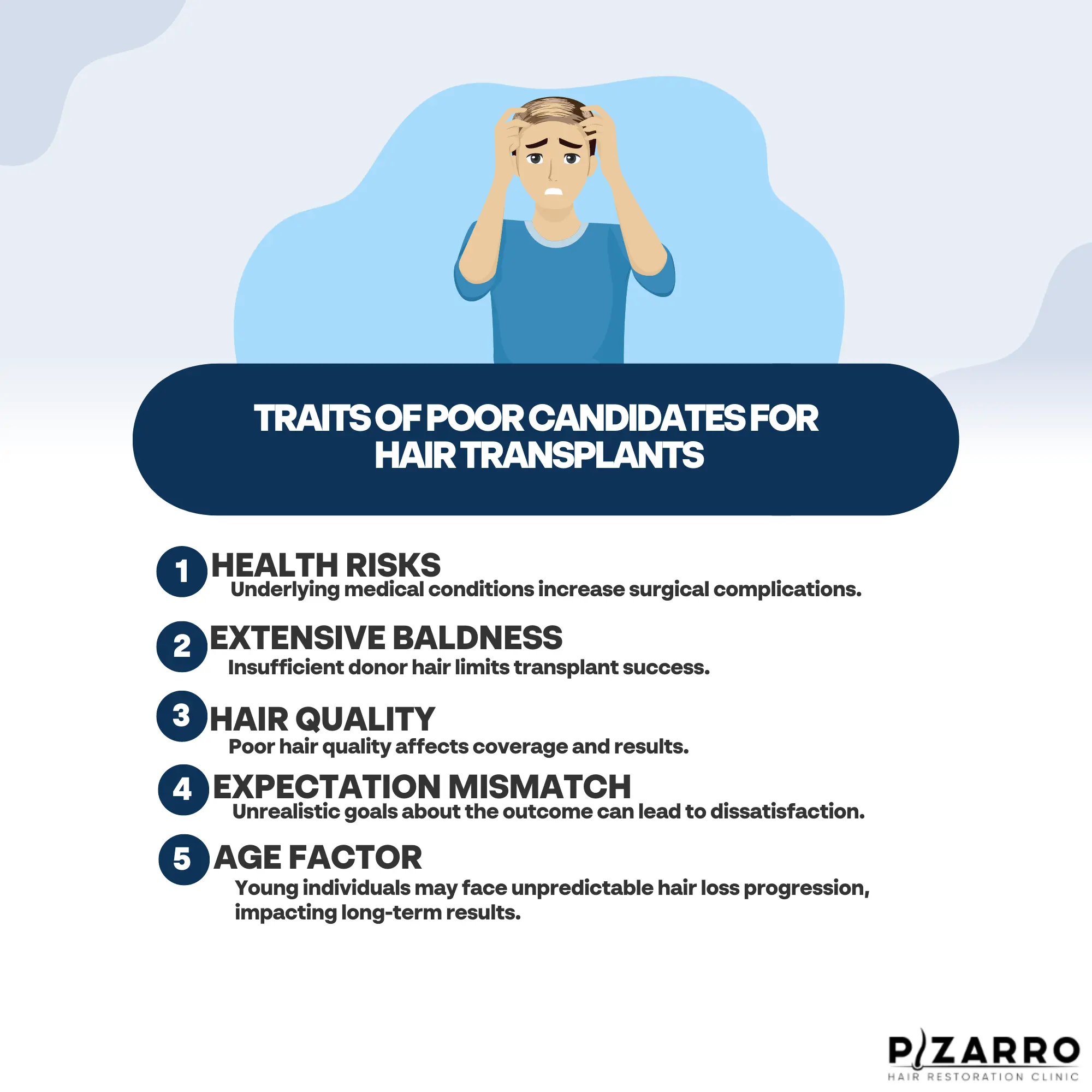Before we dive into the traits of poor candidates for hair transplants, let’s first understand what this procedure entails. Hair transplantation is a surgical procedure which removes hair follicles from a donor site or one part of the body. This is then implanted on the recipient site or the bald or thinning areas of the scalp.
The primary purpose of a hair transplant is to address androgenic alopecia or pattern baldness. This condition affects millions of men worldwide. This type of hair loss features thinning hair on the crown and receding hairline. While hair transplants can be a viable solution for men with receding hairlines, not all individuals experiencing hair loss are good candidates for this procedure.
Traits of Poor Candidates for Hair Transplants
1. Poor general health
Undergoing any surgical procedure requires a certain level of general health and well-being. Individuals with underlying medical conditions, such as uncontrolled diabetes, heart disease, or autoimmune disorders, may not be suitable candidates for hair transplants.
2. Extensive hair loss
While hair transplants can effectively treat certain types of hair loss, they may not be the best option for individuals with extensive hair loss. This is because hair transplants require an adequate supply of donor hair, and if the individual has a limited donor hair supply or their baldness is too widespread, it may not be possible to achieve the desired results.
3. Unfavorable hair characteristics
Having unfavorable hair characteristics, such as fine or naturally sparse hair, can make individuals poor candidates for hair transplants. Quality and quantity of the donor’s hair greatly dictates the success of the surgery. Suppose the individual has thin, weak, or brittle hair. In that case, it may not provide sufficient coverage or produce the desired aesthetic outcome.
4. Unrealistic expectations
One of the essential factors in determining the success of any cosmetic procedure is having realistic expectations. Individuals who expect hair transplants to give them a full head of hair akin to their appearance in their youth may be setting themselves up for disappointment. While hair transplants can effectively restore hair in the recipient site, they cannot create new hair or prevent further hair loss. Candidates must have a thorough understanding of the limitations and potential outcomes of the procedure.
5. Young age
The suitability of candidates for hair transplants is affected by age. While it may seem counterintuitive, there may be better candidates for hair transplants than individuals in their early twenties or younger. This is because hair loss patterns and the extent of baldness can be unpredictable in younger individuals. Undergoing a hair transplant at a young age may not provide a lasting solution, as the individual’s hair loss may continue progressing, requiring additional procedures.
6. Insufficient donor hair
As mentioned earlier, an adequate supply of donor hair is crucial for the success of a hair transplant. Individuals with limited donor hair, such as those who have undergone multiple hair transplant procedures in the past or have significant scarring on the donor site, may not be suitable candidates. In such cases, the risks of further hair loss or complications from the surgery may outweigh the potential benefits.
7. Active hair loss
Individuals experiencing active hair loss, where their hair is still progressively thinning or falling out, may be poor candidates for immediate hair transplants. Stability and predictability of the hair loss pattern are also crucial factors. Suppose the individual’s hair loss is still actively advancing. In that case, there is a risk that the transplanted hair may also be lost, compromising the desired outcome.

Exploring alternative options
If you have one or more of the traits mentioned above, it doesn’t mean that all hope is lost for addressing your hair loss. Several alternative options can be considered:
1. Medications
Medications, such as minoxidil (Rogaine) and finasteride (Propecia), can, in some cases, promote hair growth and slow down the hair loss process. However, these medications may only work for some, and their effectiveness can vary.
2. Scalp micropigmentation
This procedure involves tattooing the scalp to create the appearance of hair. It is a suitable option for individuals who prefer a shaved or closely cropped hairstyle.
3. Wigs or hairpieces
Wearing wigs or hairpieces can be an effective way to achieve a desired aesthetic without undergoing surgery.
4. Laser therapy
Low-level laser therapy can stimulate hair growth. It is often used in conjunction with other hair loss treatments.
Conclusion
While hair loss treatment seems like a default solution, with certain types of hair loss, they are not suitable. A good candidate for a hair transplant requires having the right traits, such as good general health, realistic expectations, and sufficient donor hair. If you have poor candidacy traits, exploring alternative options and working with a medical professional to find the best course of action for your hair loss concerns is essential.
At Pizarro Hair Restoration, we understand the emotional effect of hair loss and we want you to make the best decision for your hair. If you’re considering a hair transplant or exploring other hair restoration options, our team of experts is here to help. Please schedule a consultation with us today and take the first step toward regaining your confidence.
Interested in a hair transplant in Florida?
If you’re looking for Florida hair transplant experts, Pizarro Hair Restoration can help. Your comfort and satisfaction is our top priority. Schedule a consultation today to take the first step toward restoring your hair and confidence.






